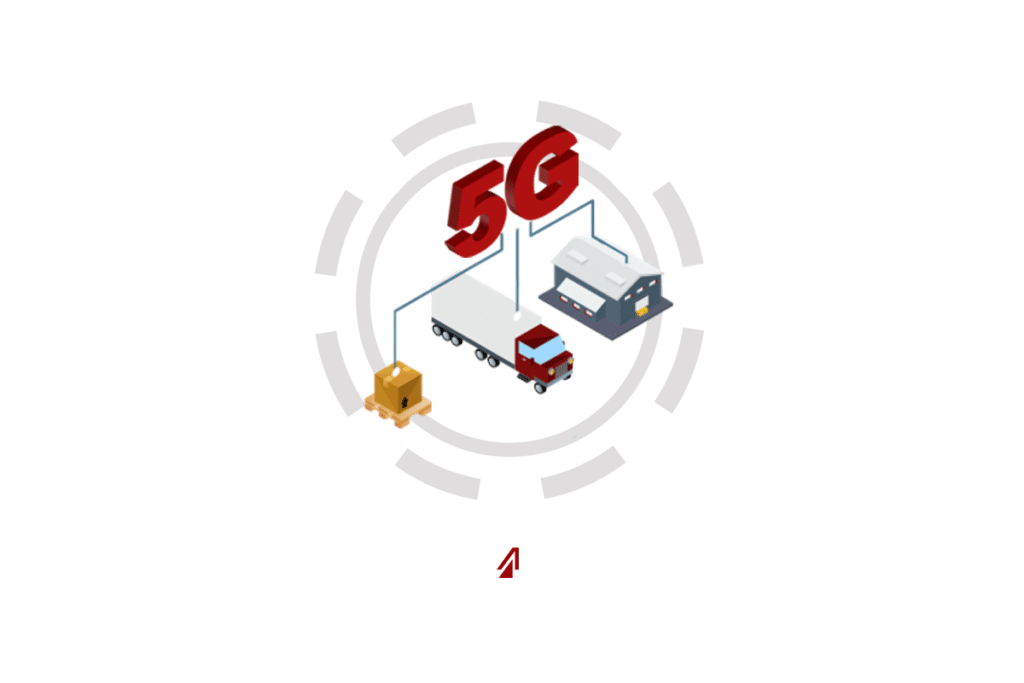5G is about to change logistics forever. It is faster, has higher capacity, and is more reliable than its predecessors and that will revolutionize communication and control for the entire shipping industry. While the idea of 5G is not new, some may not quite understand the full scope of how it will affect logistics.
What is 5G?
First things first – what is 5G? It stands for 5th generation wireless system, and it succeeds the current 4G model. Currently, 4G uses frequency signals from 2 GHz to 8 GHz but the new 5G will be use “millimeter waves” that broadcast at frequencies 30 GHz to 300 GHz. These “millimeter wave” frequencies were previously only used for satellite and radar systems but can now be broadcast for everyday use.

Not only will it use higher pitched frequencies, but it will be considerably faster as well. While 4G tops out at speeds of 100 megabits per second, 5G will be as fast as 10 gigabits per second. That is 100 times faster than the current speed wireless can download and process. Large files, like movies or reports that would take around six minutes to download, can download in about 3.6 seconds. This means faster data transfers with less interference and interruption.
So, what can this extra speed do for logistics?
5G and OTR
The increased speed and visibility 5G offers has limitless potential for logistics and society as a whole. City planners and developers are looking to integrate 5G technology in future municipal designs. Providers like AT&T business promote end-to-end connectivity across cities and beyond. Others, like DHL’s President of Global Technology, Rob Siegers, claim that this innovation will mean 100% internet access with no white spots. Apart from unified networks and connectivity, 5G offers OTR drivers more safety and reliability, better battery life, and other new, more efficient technologies.
Unified Networks and Connectivity
Currently, cities use many different networks for each of their systems – traffic lights, power grids, water, etc. Each of these systems is in an application silo, and it is difficult for them to interact with each other. 5G is expected to change that. It will use integration gateways to unify short-range communication technologies – allowing these systems to talk with one another or with vehicles on the road. 5G will allow passenger automobile or commercial motor vehicles to interact with each other (V2V) or with the city infrastructure itself (V2I).
In previous blogs, it was discussed how bottlenoses and traffic jams are leading causes of delays and needless pollution into the atmosphere. Using 5G technology, trucks will be able to interact with sensors on traffic lights, bridges, roads, or other vehicles to let each other know they are there. Drivers can avoid more accidents with cars or roadways by having greater visibility of where they are in relation to the other bodies. Traffic lights can favor specific types of vehicles or traffic to allow them to pass through more quickly and reduce congestion (and subsequently, all that goes with it). 5G will allow each of these systems to speak the same language and that makes logistics safer and more reliable.
Safety and Reliability
Increased visibility makes drivers safer and ensures stronger reliability for customers. Not only will drivers be able to interact with one another directly, making them safer, but they will also be able to stay in contact with centralized control systems. Truck drivers can be in direct contact with their dispatchers and be up-to-date on unforeseen issues like weather, traffic patterns, or road conditions. Drivers experiencing these pressures, along with new routes, are among the top reasons for driver crashes in 2017 according to FMCSA. 5G allows drivers to contact their dispatch teams or emergency services in severe situations. Having 100% connectivity allows for calls in any area without white spots.
Not only will 100% connectivity be beneficial in emergencies, but it will also revolutionize current day-to-day shipping operations, giving customers total visibility. Today, most trucks rely on costly GPS transponders or cell phone applications that can only transmit when it has service. But, with 5G, trucks will be easier to track and trace than ever. New vehicles will be built with 5G transponders in them to automatically relay information. These systems can relay large scale details like location and ETA but can also record and relay minute details like tire pressure or fuel levels. This gives the dispatch team full visibility of the driver’s conditions and can give accurate, instantaneous information to the customer.
Those that cannot implement new vehicles will still be able to benefit from 5G mobile options. Traditional cell phones will be replaced with high speed devices that have greater tracking capabilities. These will allow smaller operations to provide the same visibility as their larger competitors.
Extended Life of IoT Batteries
One of the largest battery drains for IoT devices today is searching for service. 5G promises almost total connectivity meaning that devices should have superior service wherever they are. This means less charging and longer battery life itself.
New Technologies
5G is certain to improve current technologies and create new and enhanced technologies that have yet to be discovered. Some current technologies, like virtual reality, can be enhanced with 5G data speeds. Drivers can train in real-life scenarios without expensive equipment or put themselves or company equipment at risk. They could be used for personal reasons like following up with home-life or for technical reasons like being used to identify causes of accidents. Other technologies, like mixed reality, can become widespread. This could allow for anything from heads-up navigational displays, overlaid on the true environment, to visual scan of product labels to ensure the correct BOLs are onboard.
5G has limitless potential for OTR trucks and drivers and is sure to change how freight moves in the future. However, OTR is only one segment of the supply chain that will be affected. Another crucial portion is 5G connectivity in the warehouse.
5G and the Warehouse
OTR will not be the only part of logistics to be revolutionized by 5G; the modern warehouse will be as well. 5G will improve the hardware, software, and network of warehouses today.
Hardware
5G bandwidth will allow warehouses to do more than ever before. Currently, warehouse automation and robotics is possible, but when companies utilize 4G or WIFI, they cannot experience these technologies’ full potential. Current models require significant data transfer for mapping and processing information and 4G and WIFI are unable to handle the output. 5G will change all of that.
5G estimates that it can service more than 1 million sensors within a square kilometer – far outstripping WIFI or 4G’s capabilities. This means more flexibility and greater functionality for these emerging automated processes. “Wi-Fi was never really designed to support all of these things … 5G will organize a lot of these types of applications in a more layered and a more robust and cost-effective way,” David Mindell, CEO and Founder of Humatics.
Not only is the network incapable, but the warehouse layout is as well. Current warehouses are not built with the wireless capabilities needed to control these devices. Most rely on hardwired solutions that lack flexibility for warehouse design. They are also complex systems and are costly to maintain. 5G will have wireless connectivity, even in thick-walled concrete industrial spaces, that allow these new technologies to flourish.
Automation and robotics are not the only tech receiving an upgrade from 5G – IoT devices will as well. Within the last decade, wireless internet device popularity has exploded, especially in warehouses. According to Bloomberg, it is estimated that the 11 billion IoT devices currently in use will skyrocket to 125 billion by 2030. Wireless scanners, tablets, phones – these all rely on quick internet access and have become essential warehouse tools. With the introduction of 5G, these devices will be able to process data faster, be able to store more data, and have longer battery life. Warehouse designers will be able to map their space with quick guides for workers and make picking, processing, or inventory quick and efficient. 5G will also be able to handle considerably more devices at one time than 4G or WIFI.
Software and Networking
One of the key aspects to 5G’s efficiency is its network capability. 4G or WIFI require numerous short-range transmitters that often can only cover smaller areas and leave gaps in others. 5G will provide strong, continuous signal throughout an entire warehouse space. “5G could provide ubiquitous coverage for a large warehouse rather than dealing with seven different short-range wireless standards. It can cover a very large warehouse area with one single wireless access medium, which is secure and handles all of those privacy issues,” says Serhad Doken, Executive of Emerging Technology Incubation and Innovation, 5G Ecosystems, at Verizon.
Staple technologies, like warehouse management software will see an upgrade from 5G as well. 5G will support next-level computing that will enhance WMS to build centrally controlled networks that are capable of quicker, more precise data processes. This will allow for better mapping, 3D modeling, and analysis to determine the correct position, path, and timing of products.
5G Drawbacks
5G has overwhelming positive aspects and promises a technologically transformed world, but it may come at a cost. Some protesters claim 5G will spur greater health concerns, will have significant rollout challenges, and threaten modern workers by automation.
Health
Currently, the health effects of 5G are not fully understood. Like all wireless technology, 5G is a radiofrequency that poses risks for concerns like cancer, headaches, dizziness, and fatigue. According to Environmental Health Trust, over 240 scientists from 41 nations have appealed to the United Nations with concerns about the effects of 5G. Some site grave concerns and others merely speculate that more research is needed on the “millimeter waves” and their effect on humans.
Test cities have been rolling out 5G with a bit of pushback from the local citizens affected by the new technology as well. Some claim that the proximity of themselves to the broadcast antennas makes them more liable to develop illnesses. Others claim that these can affect property values. However, no definitive proof is available yet.
Rollout
Another major concern is the deployment of 5G, as well as the time and money needed to develop the necessary devices needed to produce 5G. The nature of “millimeter waves” prevents them from passing easily through large objects like cement walls, and the waves typically weaken over long distances. So, instead of large cell phone towers, like 4G uses, 5G will be transmitted by many smaller short-range antennae. Companies like Verizon and AT&T are looking to be unobtrusive with the new technology and utilize current structures like lampposts or telephone poles to hold the transmitters. Still, installing these structures, as well as creating compatibility between networks will be a challenge. Proponents boast that it will provide nearly global coverage, but it will take considerable effort to install transmitters in remote areas of the U.S. let alone in less developed nations.
Outmoding Employment
5G may see the end of many traditional jobs. In logistics, jobs like traditional truck driving or warehouse work may become a thing of the past. 5G will usher in cheaper labor from automation or robotics and displace traditional workers. Threats from tech platforms are a concern as well (ARE TECHNO-BROKERS THE WAY OF THE FUTURE PART 1, PART 2) for third party providers. 5G will replace older industries with newer ones, and workers will be forced to adapt.
Overall, even with the looming challenges, 5G will positively revolutionize logistics. It will make shipping safer and easier, allow for greater connectivity and visibility, and it will usher in new and exciting technology that will enhance peoples’ lives. In warehouses, it will make technologies smarter and easier, provide clarity to managers and developers, and make connectivity faster and more reliable. 5G is on the horizon, and it is expected to be released to the general public as soon as 2020.



